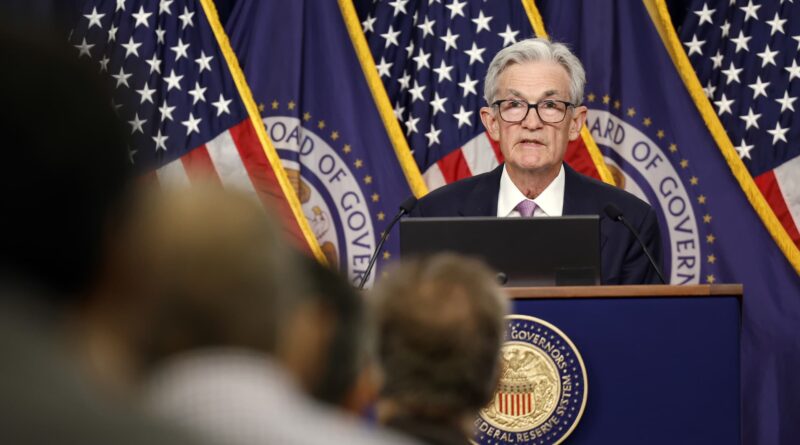Fed cuts charges by a half level at September 2024 assembly
WASHINGTON – The Federal Reserve on Wednesday enacted its first rate of interest lower for the reason that early days of the Covid pandemic, slicing half a proportion level off benchmark charges in an effort to move off a slowdown within the labor market.
With each the roles image and inflation softening, the central financial institution’s Federal Open Market Committee selected to decrease its key in a single day borrowing charge by a half proportion level, or 50 foundation factors, affirming market expectations that had just lately shifted from an outlook for a lower half that measurement.
Exterior of the emergency charge reductions throughout Covid, the final time the FOMC lower by half a degree was in 2008 through the international monetary disaster.
The choice lowers the federal funds charge to a spread between 4.75%-5%. Whereas the speed units short-term borrowing prices for banks, it spills over into multiple consumer products corresponding to mortgages, auto loans and bank cards.
Along with this discount, the committee indicated by means of its “dot plot” the equivalent of 50 more basis points of cuts by the end of the year, near market pricing. The matrix of particular person officers’ expectations pointed to a different full proportion level in cuts by the tip of 2025 and a half level in 2026. In all, the dot plot reveals the benchmark charge coming down about 2 proportion factors past Wednesday’s transfer.
“The Committee has gained better confidence that inflation is transferring sustainably towards 2 %, and judges that the dangers to attaining its employment and inflation objectives are roughly in steadiness,” the post-meeting statement said.
The choice to ease got here “in gentle of progress on inflation and the steadiness of dangers.” Notably, the FOMC vote was 11-1, with Governor Michelle Bowman preferring a quarter-point transfer. Bowman’s dissent was the primary by a Fed governor since 2005, although plenty of regional presidents have solid “no” votes through the interval.
“We’re attempting to attain a state of affairs the place we restore worth stability with out the type of painful improve in unemployment that has come generally with this inflation. That is what we’re attempting to do, and I feel you would take immediately’s motion as an indication of our sturdy dedication to attain that purpose,” Chair Jerome Powell stated at a news conference following the decision.
Trading was volatile after the choice with the Dow Jones Industrial Common leaping as a lot as 375 factors after it was launched, earlier than easing considerably as buyers digested the information and regarded what it suggests concerning the state of the economic system.
Shares ended barely decrease on the day whereas Treasury yields bounced increased.
“This isn’t the start of a collection of fifty foundation level cuts. The market was considering to itself, when you go 50, one other 50 has a excessive chance. However I feel [Powell] actually dashed that concept to some extent,” stated Tom Porcelli, chief U.S. economist at PGIM Fastened Revenue. “It isn’t that he thinks that is not going to occur, it is that he is not he is not pre-committing to that to occur. That’s the proper name.”
The committee famous that “job positive aspects have slowed and the unemployment charge has moved up however stays low.” FOMC officers raised their anticipated unemployment charge this 12 months to 4.4%, from the 4% projection on the final replace in June, and lowered the inflation outlook to 2.3% from 2.6% earlier. On core inflation, the committee took down its projection to 2.6%, a 0.2 proportion level discount from June.
The committee expects the long-run impartial charge to be round 2.9%, a stage that has drifted increased because the Fed has struggled to get inflation right down to 2%.
The choice comes regardless of most financial indicators trying pretty stable.
Gross home product has been rising steadily, and the Atlanta Fed is monitoring 3% development within the third quarter primarily based on persevering with power in shopper spending. Furthermore, the Fed selected to chop although most gauges point out inflation effectively forward of the central financial institution’s 2% goal. The Fed’s most popular measure reveals inflation operating round 2.5%, effectively under its peak however nonetheless increased than policymakers would love.
Nonetheless, Powell and different policymakers in current days have expressed concern about the labor market. Whereas layoffs have proven little signal of rebounding, hiring has slowed considerably. In actual fact, the final time the month-to-month hiring charge was this low – 3.5% as a share of the labor pressure – the unemployment charge was above 6%.
At his information convention following the July assembly, Powell remarked {that a} 50 foundation level lower was “not one thing we’re enthusiastic about proper now.”
For the second, at the very least, the transfer helps settle a contentious debate over how forceful the Fed ought to have been with the preliminary transfer.
Nonetheless, it units the stage for future questions over how far the central financial institution ought to go earlier than it stops reducing. There was a large dispersion amongst members for the place they see charges heading in future years.
Buyers’ conviction on the transfer vacillated within the days main as much as the assembly. Over the previous week, the percentages had shifted to a half-point lower, with the likelihood for 50 foundation factors at 63% simply earlier than the choice coming down, in accordance with the CME Group’s FedWatch gauge.
The Fed final diminished charges on March 16, 2020, a part of an emergency response to an financial shutdown led to by the unfold of Covid-19. It started mountaineering in March 2022 as inflation was climbing to its highest stage in additional than 40 years, and final raised charges in July 2023. Through the tightening marketing campaign, the Fed raised charges 75 foundation factors 4 consecutive instances.
The current jobless level is 4.2%, drifting increased over the previous 12 months although nonetheless at a stage that may be thought of full employment.
“This was an atypical huge lower,” Porceli stated. “We’re not knocking on recessions’ door. This easing and this bit lower is about recalibrating coverage for the truth that inflation has slowed a lot.”
With the Fed on the middle of the worldwide monetary universe, Wednesday’s resolution doubtless will reverberate amongst different central banks, a number of of whom have already got began reducing. The components that drove international inflation increased have been associated primarily to the pandemic – crippled worldwide provide chains, outsized demand for items over providers, and an unprecedented inflow of financial and financial stimulus.
The Financial institution of England, European Central Financial institution and Canada’s central financial institution all have lower charges just lately, although others awaited the Fed’s cue.
Whereas the Fed authorised the speed lower, it left in place a program by which it’s slowly decreasing the scale of its bond holdings. The method, nicknamed “quantitative tightening,” has introduced the Fed’s steadiness sheet right down to $7.2 trillion, a discount of about $1.7 trillion from its peak. The Fed is permitting as much as $50 billion a month in maturing Treasurys and mortgage-backed securities to roll off every month, down from the preliminary $95 billion when QT began.





